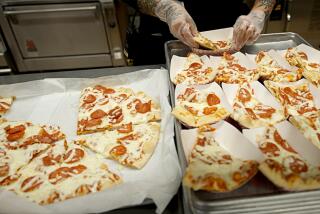Food that flies well? Skip the cookies, think trail mix
FACED with the tensions of air travel these days -- the rules that change at a moment’s notice, the lines that seem never to grow shorter, the absence of on-board sustenance -- even the most healthful eaters may be tempted to find solace in Twinkies.
Before you opt for the get-me-some-comfort-food-now! approach to stress reduction, consider other options. Here are some strategies from experts who can help you quash jitters and hunger pangs and can suggest healthful take-along food that won’t clog your arteries or boost your belly fat.
Problem: The Transportation Security Administration has banned passengers from carrying liquids on board, including water and other beverages.
Solution: Focus on staying well-hydrated the day before your flight, says Dr. Michael Steelman, chairman of the board of trustees for the American Society of Bariatric Physicians, based in Aurora, Colo. Drink six or more glasses of water and avoid dehydrating beverages, such as alcohol and caffeine-laden coffee or black tea.
Another reason to stay hydrated: “Mild dehydration can cause an increase in your appetite,” Steelman says.
Problem: Longer wait times at the airport may mean hunger strikes while you’re in line.
Solution: Before heading to the airport, eat a meal with fairly high amounts of protein, Steelman suggests. Adults should aim for 15 or 20 grams of protein, children about half that, he says. (A 3-ounce skinless chicken breast has 26 grams of protein.) If it’s breakfast, he says, try an omelet made with an egg substitute or real eggs if your cholesterol levels are not a problem. (One whole egg has about 6.25 grams of protein, according to the American Egg Board.)
Or to keep yourself feeling full, eat something with a lot of fiber, such as a high-fiber cereal or old-fashioned oatmeal. “Not instant,” Steelman says, because it tends to have too much sugar.
For a lunch or dinner pre-flight meal, eat a salad with grilled chicken or other meat to get enough protein, he says. The protein will stave off hunger pangs longer than if you eat a meal that is mostly high in carbohydrates.
Problem: Many airlines have cut back on on-board food; those that haven’t often serve snacks that are high in fat and sugar. Furthermore, new TSA rules about what can and cannot be taken on board are confusing.
Solution: Pack healthful comfort-food snacks that meet TSA requirements.
Fill plastic bags with almonds, walnuts and granola that you mix yourself. “Store-bought granola often has a high sugar content,” Steelman says. If you want to sweeten your own granola, mix in a few dark chocolate chips, he advises, because dark chocolate has been found to be beneficial to heart health.
Put snacks in portion-controlled bags; there’s less of a chance of overeating.
Before a recent family trip to Hawaii, Jeannie Moloo, a Sacramento dietitian and spokeswoman for the American Dietetic Assn. in Chicago, let her children, ages 4, 8 and 11, make their own snack bags of trail mix. They filled plastic food bags with cereal, almonds, pecans, cranberries and raisins. “Hungry kids don’t make good travel companions,” she says.
Pack grapes left on the stem. “Pulling the grapes off the stem as you eat them will take care of a little of that anxiety,” Steelman suggests.
Pop your own popcorn to take with you, says Cynthia Sass, a registered dietitian in Tampa, Fla., and another media spokeswoman for the American Dietetic Assn.
Take baby carrots, peeled and washed. “They taste fine at room temperature, and they won’t get mushy,” Sass says.
Try meal replacement bars, choosing those without a lot of sugar.
Baked goods are comforting, but try to stick with more healthful options, such as oatmeal raisin cookies or muffins or breads made with oats or whole wheat, nuts and fruit, such as pumpkin bread or carrot muffins with walnuts and raisins.
All the snacks suggested by Steelman, Moloo and Sass are acceptable in carry-on luggage or on your person, says Jennifer Peppin, a spokeswoman for the TSA. Use clear plastic bags to store snacks, she advises, because they make visual inspection easier.
But leave the jars of peanut butter at home. The TSA’s rules now prohibit it in carry-on luggage. (For information on prohibited food items, see the TSA site, www.tsa.gov.)
Security delays mean you should not pack perishable foods. The gap between arriving at the airport and getting the all-clear to put down your tray table when you are aloft can easily be two hours, Moloo says.
Problem: The stress gets to you, and you eat that whole basket of French fries.
Solution: Janet Wallace, a professor of kinesiology at Indiana University Bloomington, has some comforting words for you.
Engaging in moderate exercise about two hours after a high-fat meal appears to help remedy its negative effect on the arteries, Wallace and her team report in the current online issue of the European Journal of Applied Physiology.
Although the study was too small to extrapolate to the general population, Wallace says she’s convinced of exercise’s efficacy.
“Exercise does great things, and this obviously shows exercise is very effective in counteracting that high-fat meal,” she says.
*
More to Read
Sign up for The Wild
We’ll help you find the best places to hike, bike and run, as well as the perfect silent spots for meditation and yoga.
You may occasionally receive promotional content from the Los Angeles Times.






